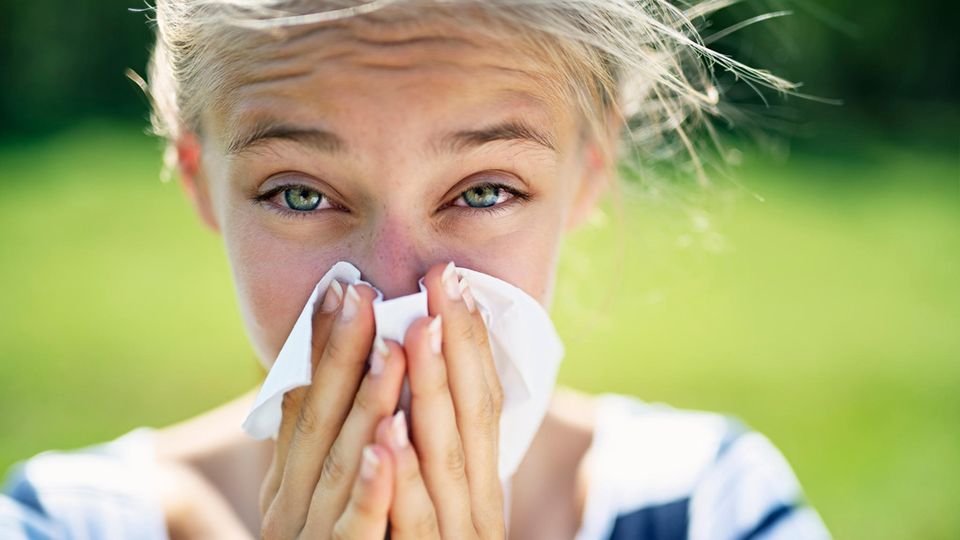Non-allergic rhinitis
Hay fever or not? Why some people have symptoms but no allergy
Hay fever can be stressful. But when a persistent cold sets in in spring, there is not always an allergy behind it
© Getty Images
Hay fever or no hay fever, that is the question for many people who sniffle and sneeze in the spring. Because pollen counts and a persistent cold often go hand in hand. However, there is not always an allergy behind it. Tips against non-allergic rhinitis.
Spring time is hay fever time. For around 12 million people in Germany, the worst weeks of the year begin with the pollen count. The pollen from hazel, alder, birch, etc. ensures that allergy sufferers stay safe for weeks Symptoms such as itchy eyes, sore throat, shortness of breath, runny or stuffy nose and cascades of sneezing.
But it is not always hay fever when the upper respiratory tract is in turmoil and all symptoms point to hay fever. There are people who have symptoms of an allergy but for whom an allergy test turns out negative. Good advice is often expensive.
Constant cold, but not hay fever
In fact, typical allergy symptoms that affect the nose can also be due to non-allergic rhinitis. This persistent cold is a disease caused by inflammation of the nasal mucosa. In most cases, but not exclusively, viruses are responsible. The inflammation causes the mucous membrane to swell and produce more mucus.
The symptoms of non-allergic rhinitis are similar to allergic rhinitis – from itchy nose and sneezing to heavy mucus flow and stuffy nose. The symptoms can occur seasonally but also all year round. Unlike allergic rhinitis, the symptoms are not triggered by an infection or allergens such as pollen, dust mites or animal hair. It is not yet clear what exactly causes the non-allergic persistent cold. A reaction can be caused by a variety of environmental stimuli. The complaints of those affected are just as unspecific. It is estimated that 25 to 50 percent of rhinitis patients are affected by a form of non-allergic rhinitis.
The many faces of non-allergic rhinitis
The term non-allergic rhinitis is an umbrella term that includes several forms of cold, all of which have different symptoms and triggers.
This includes hormonal rhinitis that occurs during pregnancy. But also nasal problems that occur in old age (senile rhinitis), after eating spicy foods (gustatory rhinitis), due to certain medications such as anti-rheumatic drugs or beta-blockers (drug-induced rhinitis) and regular contact with certain substances such as chemical vapors at the workplace ( Occupational rhinitis) belongs to the group of non-allergic inflammations of the nasal mucosa.
Idiopathic rhinitis occurs most frequently, i.e. a persistent cold that is not due to “one” trigger. is attributable. For some it is cigarette smoke, for others it is a strong smell of food or perfume, for others the runny nose is caused by temperature changes or stress.
If non-allergic rhinitis causes symptoms affecting the eyes, such as tears or burning, it is referred to as non-specific conjunctivitis. If the bronchi are affected by hypersensitivity, this is referred to as non-specific bronchial hyperactivity. Her symptoms include shortness of breath and cough.
What helps against rhinitis?
Non-allergic rhinitis is not a life-threatening condition. However, the persistent cold can still be a stress test for those affected and severely restrict their everyday life. The non-allergic persistent cold is varied and can be very individual. If symptoms persist, you should consult a doctor so that optimal treatment – sometimes with medication – is possible.
But those affected can also do a few things to alleviate their symptoms:
- Identification of triggers: Keep a diary of your symptoms to identify possible triggers.
- Avoiding known triggers: Once you’ve identified your triggers, try to minimize contact with them. These can be, for example, certain foods, chemical fumes or strong smells.
- Regular ventilation of living spaces: Regular ventilation improves the air quality indoors and potential irritants can be filtered out.
- Smoking avoidance: Avoid secondhand smoke and reduce your own cigarette consumption, as cigarette smoke can increase the symptoms of non-allergic rhinitis.
- Hygiene: Good nasal hygiene can help reduce symptoms. Use salt water solutions or nasal douches to clean the nasal cavity and remove excess mucus.
- Stress reduction: Stress can worsen the symptoms of non-allergic rhinitis. Try to reduce stress and integrate relaxation techniques such as yoga, meditation or breathing exercises into your everyday life.
- Healthy lifestyle: A healthy diet, enough exercise and enough sleep can strengthen the immune system and reduce the symptoms of non-allergic rhinitis.
- Consultation with a specialist: If symptoms are severe or do not improve, it is advisable to consult a specialist and discuss an individual treatment strategy.
Sources: Robert Koch Institute, National Library of Medicine, Cochrane Library, Quarks, MSD Manuals, My allergy portal


